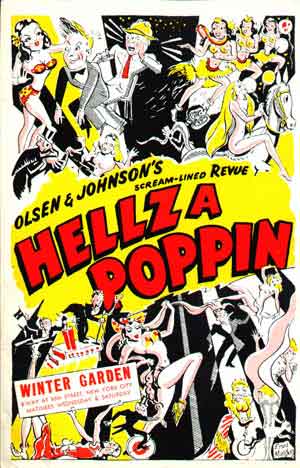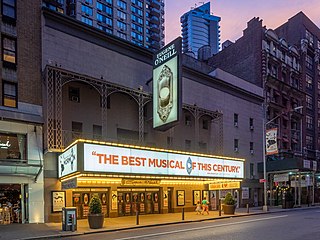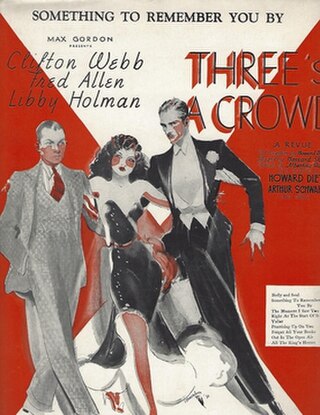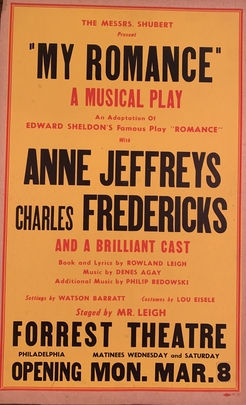
The Winter Garden Theatre is a Broadway theatre at 1634 Broadway in the Midtown Manhattan neighborhood of New York City. It opened in 1911 under designs by architect William Albert Swasey. The Winter Garden's current design dates to 1922, when it was completely remodeled by Herbert J. Krapp. Due to the size of its auditorium, stage, and backstage facilities, it is favored for large musical productions. It has 1,600 seats and is operated by The Shubert Organization. The auditorium interior is a New York City landmark.

Howard Dietz was an American publicist, lyricist, and librettist, best remembered for his songwriting collaboration with Arthur Schwartz.

Hellzapoppin is a musical revue written by the comedy team of Olsen and Johnson, consisting of John "Ole" Olsen and Harold "Chic" Johnson, with music and lyrics by Sammy Fain and Charles Tobias. The revue was a hit, running for over three years, and was at the time the longest-running Broadway musical, with 1,404 performances, making it one of only three plays to run more than 500 performances in the 1930s.

The Shubert Theatre is a Broadway theater at 225 West 44th Street in the Theater District of Midtown Manhattan in New York City. Opened in 1913, the theater was designed by Henry Beaumont Herts in the Italian Renaissance style and was built for the Shubert brothers. Lee and J. J. Shubert had named the theater in memory of their brother Sam S. Shubert, who died in an accident several years before the theater's opening. It has 1,502 seats across three levels and is operated by The Shubert Organization. The facade and interior are New York City landmarks.

Joseph Stein was an American playwright best known for writing the books for such musicals as Fiddler on the Roof and Zorba.

Nathan Hiken was an American radio and television writer, producer, and songwriter who rose to prominence in the 1950s.

The Broadway Theatre is a Broadway theater at 1681 Broadway in the Theater District of Midtown Manhattan in New York City. Opened in 1924, the theater was designed by Eugene De Rosa for Benjamin S. Moss, who originally operated the venue as a movie theater. It has approximately 1,763 seats across two levels and is operated by The Shubert Organization. The Broadway Theatre is one of the few Broadway theaters that is physically on Broadway.

The John Golden Theatre, formerly the Theatre Masque and Masque Theater, is a Broadway theater at 252 West 45th Street in the Theater District of Midtown Manhattan in New York City. Opened in 1927, the Golden Theatre was designed by Herbert J. Krapp in a Spanish style and was built for real-estate developer Irwin S. Chanin. It has 800 seats across two levels and is operated by The Shubert Organization. Both the facade and the auditorium interior are New York City landmarks.

The Eugene O'Neill Theatre, previously the Forrest Theatre and the Coronet Theatre, is a Broadway theater at 230 West 49th Street in the Theater District of Midtown Manhattan in New York City. The theater was designed by Herbert J. Krapp and was constructed for the Shubert brothers. It opened in 1925 as part of a hotel and theater complex named after 19th-century tragedian Edwin Forrest. The modern theater, named in honor of American playwright Eugene O'Neill, has 1,108 seats across two levels and is operated by Jujamcyn Theaters. The auditorium interior is a New York City designated landmark.
Oliver Smith was an American scenic designer and interior designer.
Inside U.S.A. is a musical revue by Arthur Schwartz (music) and Howard Dietz (lyrics). It was loosely based on the book Inside U.S.A. by John Gunther. Sketches were written by Arnold M. Auerbach, Moss Hart, and Arnold B. Horwitt.

Lend an Ear is a musical revue with a book, music, and lyrics by Charles Gaynor and additional sketches by Joseph Stein and Will Glickman.
Thomas Montgomery Adair was an American songwriter, composer, and screenwriter.

The Forrest Theatre is a live theatre venue at 1114 Walnut Street Center City area of Philadelphia, Pennsylvania. It has a seating capacity of 1,851 and is managed by The Shubert Organization.
Margaret Brownson Clark was a lighting designer, costume designer, and set designer. She designed lighting for dance and opera, but she "is best known for her work on [stage] musicals".

Willie Howard and Eugene Howard, billed as the Howard Brothers, were Silesian-born American vaudeville performers of the first half of the 20th century. They were two of the earliest openly Jewish performers on the American stage.

Make Mine Manhattan is a 1948 Broadway revue with music by Richard Lewine, lyrics by Hassard Short, and sketches by Arnold Horwitt and produced by Joseph Hyman.

Three's A Crowd is a 1930 Broadway revue with lyrics by Howard Dietz and others, and music by Arthur Schwartz and others. It was “put together” by Howard Dietz, and produced by Max Gordon.

Jack Whiting was an American actor, singer and dancer whose career ran from the early 1920s through the late 1950s, playing leading men or major supporting figures.

My Romance is a musical comedy in three acts with book and lyrics by Rowland Leigh, and music by Sigmund Romberg. It was produced on Broadway in 1948.
















